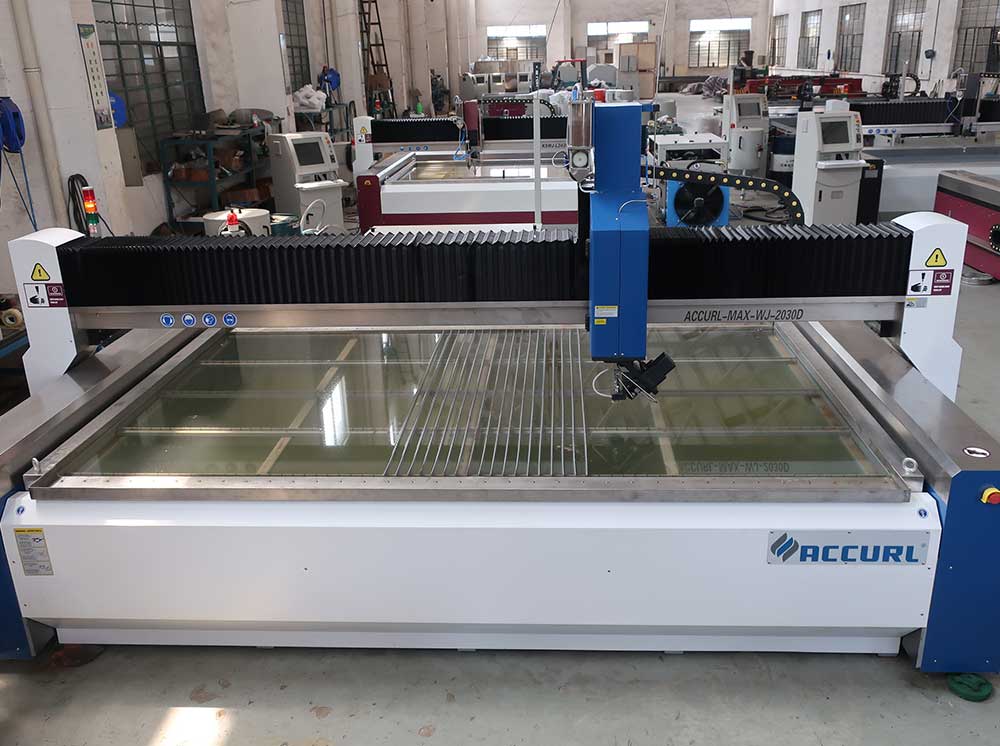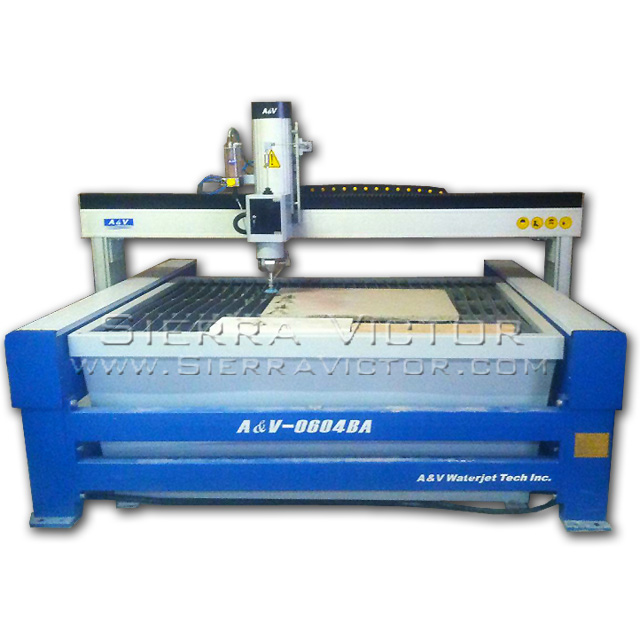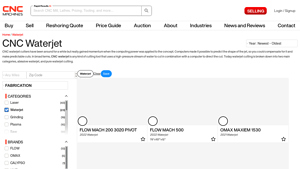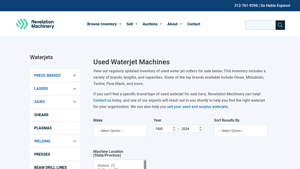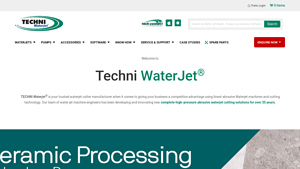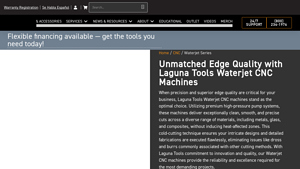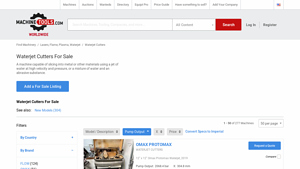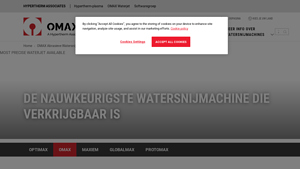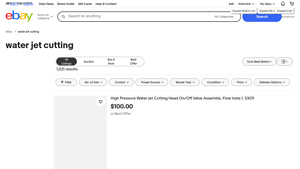Water Jet Machines For Sale Guide: Type, Cost, Top List…
Introduction: Navigating the Global Market for water jet machines for sale
In the ever-evolving landscape of industrial manufacturing, sourcing water jet machines for sale can present a significant challenge for B2B buyers across the globe. With an increasing demand for precision cutting solutions, businesses in regions such as Africa, South America, the Middle East, and Europe are tasked with navigating a complex market filled with varied machine types and specifications. This guide aims to demystify the process, providing insights into the different categories of water jet machines—such as abrasive and pure waterjet cutters—and their specific applications across various materials.
Understanding the nuances of water jet technology is crucial for informed purchasing decisions. This comprehensive resource will address key considerations, including supplier vetting processes, cost analysis, and maintenance requirements. We will also explore the operational efficiencies that modern water jet machines can bring to your production line, enhancing productivity and reducing waste.
By equipping international buyers with actionable insights and practical knowledge, this guide empowers businesses to make strategic investments in water jet technology that align with their operational goals. Whether you are a seasoned procurement professional or new to the market, understanding the intricacies of water jet machines will enable you to leverage this cutting-edge technology to meet your production needs and stay competitive in a global marketplace.
Understanding water jet machines for sale Types and Variations
| Type Name | Key Distinguishing Features | Primary B2B Applications | Brief Pros & Cons for Buyers |
|---|---|---|---|
| Abrasive Waterjet Cutter | Utilizes a high-pressure stream mixed with abrasive materials | Metal fabrication, stone cutting, aerospace | Pros: Cuts hard materials, versatile. Cons: Higher operating costs due to abrasives. |
| Pure Waterjet Cutter | Uses only high-pressure water for cutting | Food industry, softer materials, textiles | Pros: Minimal material distortion, lower running costs. Cons: Limited to softer materials. |
| CNC Waterjet Systems | Computer-controlled for precision and efficiency | Automotive parts, custom designs, prototyping | Pros: High precision, reduced labor costs. Cons: Initial investment can be high. |
| Portable Waterjet Systems | Compact and mobile, ideal for fieldwork | Construction sites, maintenance, repair | Pros: Flexibility, easy transport. Cons: Limited cutting capacity compared to larger systems. |
| Multi-Head Waterjet Cutter | Equipped with multiple cutting heads for increased output | High-volume manufacturing, large-scale projects | Pros: Higher productivity, reduced cycle time. Cons: More complex setup and maintenance. |
What Are the Characteristics of Abrasive Waterjet Cutters?
Abrasive waterjet cutters are designed to mix high-pressure water with abrasive materials, allowing for the cutting of harder substances like metals and stone. This versatility makes them ideal for industries such as aerospace and heavy machinery, where precision and durability are paramount. When considering this type, buyers should evaluate the cost of abrasives, as well as the maintenance needs associated with these systems.
How Do Pure Waterjet Cutters Differ in Application?
Pure waterjet cutters utilize only water to create cuts, making them suitable for softer materials such as rubber and food products. This type of machine is particularly advantageous in sectors that require minimal heat distortion, such as textiles and food processing. Buyers should consider the types of materials they typically work with and the potential limitations of pure waterjet systems in terms of thickness and material hardness.
Why Choose CNC Waterjet Systems for Precision Cutting?
CNC waterjet systems are renowned for their precision and efficiency, making them a popular choice in automotive and custom manufacturing. These machines are computer-controlled, allowing for intricate designs and repeatable accuracy. When purchasing, businesses should assess their programming capabilities and the potential for integration with existing systems, as well as the initial capital investment required.
What Are the Benefits of Portable Waterjet Systems?
Portable waterjet systems offer flexibility and mobility, making them ideal for on-site applications such as construction and maintenance. These compact machines can be easily transported to various locations, providing convenience without compromising on cutting quality. Buyers should weigh the benefits of portability against the potential limitations in cutting capacity and material thickness.
How Do Multi-Head Waterjet Cutters Enhance Production?
Multi-head waterjet cutters are equipped with several cutting heads, which significantly increase productivity and reduce cycle times for high-volume manufacturing. This feature is particularly beneficial for large-scale projects that require consistent output. When considering this type, buyers should factor in the complexity of setup and maintenance, alongside the advantages of increased throughput and efficiency.
Key Industrial Applications of water jet machines for sale
| Industry/Sector | Specific Application of water jet machines for sale | Value/Benefit for the Business | Key Sourcing Considerations for this Application |
|---|---|---|---|
| Aerospace | Precision cutting of composite materials for aircraft components | Ensures high accuracy and minimal material waste, enhancing safety and performance | Look for machines with high-pressure capabilities and advanced CNC controls to handle complex shapes. |
| Automotive Manufacturing | Cutting intricate parts from metals and plastics | Increases production efficiency and allows for complex designs without compromising material integrity | Consider the machine’s ability to handle various materials and thicknesses, and ensure it complies with industry standards. |
| Construction & Architecture | Water jet cutting for stone, tile, and glass in architectural designs | Provides design flexibility and precision in custom projects, minimizing waste | Evaluate the machine’s versatility for different materials and its ease of integration into existing workflows. |
| Metal Fabrication | Fabrication of metal components for machinery and structures | Offers clean cuts with no heat-affected zones, reducing post-processing work | Focus on machines that can accommodate large sheet sizes and have a reliable supply of abrasive materials. |
| Food Processing | Cutting food products such as meat and vegetables | Maintains hygiene and minimizes cross-contamination while allowing for precise shapes | Ensure compliance with food safety standards and consider the machine’s ease of cleaning and maintenance. |
How Are Water Jet Machines Used in Aerospace Applications?
In the aerospace industry, water jet machines are employed for precision cutting of composite materials used in aircraft components. The ability to produce intricate shapes with minimal waste is crucial, as even slight inaccuracies can affect performance and safety. International buyers, especially from regions like Europe and the Middle East, should consider sourcing machines that offer high-pressure capabilities and advanced CNC controls to handle complex geometries effectively.
What Role Do Water Jet Machines Play in Automotive Manufacturing?
Water jet machines are integral to automotive manufacturing, where they cut intricate parts from metals and plastics. This technology enhances production efficiency by allowing complex designs without compromising the integrity of the materials. Buyers from South America and Africa should prioritize machines that can handle various materials and thicknesses while ensuring compliance with stringent automotive industry standards.
How Do Water Jet Machines Benefit Construction and Architecture?
In the construction and architectural sectors, water jet cutting is utilized for shaping stone, tile, and glass, providing design flexibility and precision in custom projects. The technology minimizes waste and allows for intricate designs that traditional cutting methods may not achieve. Buyers should evaluate machines for their versatility in handling different materials and ease of integration into existing workflows, particularly in diverse markets across Africa and Europe.
Why Are Water Jet Machines Essential in Metal Fabrication?
Metal fabrication benefits significantly from water jet machines, which create clean cuts without heat-affected zones. This characteristic reduces the need for extensive post-processing work and ensures the integrity of the metal components. When sourcing machines, it is essential to focus on those that can accommodate large sheet sizes and maintain a reliable supply of abrasive materials, especially for buyers in fast-growing markets.
How Are Water Jet Machines Used in Food Processing?
In food processing, water jet machines are employed to cut products like meat and vegetables, ensuring hygiene and minimizing cross-contamination. The precision offered by water jet technology allows for unique shapes while adhering to food safety standards. Buyers should consider machines that are easy to clean and maintain, particularly in regions where food safety regulations are stringent, such as Europe and the Middle East.
3 Common User Pain Points for ‘water jet machines for sale’ & Their Solutions
Scenario 1: Sourcing High-Quality Used Water Jet Machines
The Problem:
For many B2B buyers, particularly in regions like Africa and South America, sourcing high-quality used water jet machines can be a daunting task. Buyers often face the challenge of distinguishing between reputable sellers and those offering subpar or damaged equipment. The risk of investing in a machine that may require significant repairs can lead to substantial unplanned costs, downtime, and frustration, especially when local suppliers may not have a strong track record.
The Solution:
To effectively source high-quality used water jet machines, buyers should conduct thorough due diligence on potential suppliers. Start by checking online marketplaces and platforms specializing in industrial machinery, ensuring they have robust customer reviews and ratings. Request detailed photographs, operational history, and maintenance records of the machines. Engaging a third-party inspection service can also provide an unbiased assessment of the machine’s condition. Additionally, consider sourcing from manufacturers or distributors with a reputation for quality and customer support, as they may offer warranties or return policies that provide further assurance.
Scenario 2: Understanding the Types of Water Jet Machines Available
The Problem:
B2B buyers often find themselves overwhelmed by the variety of water jet machines available for sale, including differences between abrasive and pure water jet cutting systems. Without a clear understanding of the specific applications and advantages of each type, buyers may invest in a machine that does not meet their operational needs or that lacks the capabilities to cut the materials they work with, resulting in inefficiencies and wasted resources.
The Solution:
To navigate the complexities of selecting the right type of water jet machine, buyers should start by assessing their specific cutting needs, including the materials they plan to process and the required thickness. For example, abrasive water jets are ideal for harder materials like steel and granite, while pure water jets work best for softer materials such as rubber or foam. Consulting with manufacturers or knowledgeable suppliers can provide insights into the latest technologies and machine capabilities. Additionally, attending industry trade shows or workshops can offer hands-on experience and networking opportunities with experts who can advise on best practices and machine selection tailored to specific business applications.
Scenario 3: Managing Operational Costs and Maintenance
The Problem:
Once a B2B buyer has acquired a water jet machine, managing operational costs and ongoing maintenance can become significant pain points. High energy consumption, replacement of consumables (like abrasive materials), and the potential for mechanical failures can lead to unexpected expenses. Companies, especially startups or smaller manufacturers, may struggle to keep operational costs within budget, which can affect overall profitability.
The Solution:
To effectively manage operational costs, buyers should invest time in understanding the total cost of ownership (TCO) associated with their water jet machines. This includes not only the purchase price but also operational expenses such as electricity, water usage, and consumable materials. Buyers should consider machines that offer energy-efficient features and lower maintenance requirements. Implementing a regular maintenance schedule can prevent costly breakdowns and extend the machine’s lifespan. Additionally, training operators on best practices for machine use can enhance efficiency and reduce wear and tear. Exploring partnerships with suppliers for bulk purchasing of consumables can also yield cost savings. Regularly reviewing these costs against production outputs can help businesses identify areas for improvement and optimize their operations.
Strategic Material Selection Guide for water jet machines for sale
What Are the Key Materials for Water Jet Machines and Their Applications?
When considering water jet machines for sale, the selection of materials is critical for ensuring optimal performance and suitability for specific applications. Below is an analysis of four common materials used in water jet cutting, focusing on their properties, advantages, disadvantages, and considerations for international buyers.
1. Steel
Key Properties: Steel exhibits excellent strength and durability, with a high-temperature rating and resistance to deformation under pressure. It is often used in various grades, including stainless steel, which offers additional corrosion resistance.
Pros & Cons: The primary advantage of steel is its robustness, making it suitable for heavy-duty applications. However, it can be more expensive than other materials, particularly stainless steel, and may require additional processing to achieve desired finishes.
Impact on Application: Steel is ideal for cutting components in automotive, aerospace, and construction industries. Its compatibility with abrasive water jet cutting allows for precise cuts in thicker sections.
Considerations for International Buyers: Buyers should ensure compliance with international standards such as ASTM A36 for carbon steel or ASTM A240 for stainless steel. Different regions may have preferences for specific grades based on local manufacturing practices.
2. Aluminum
Key Properties: Aluminum is lightweight with a good strength-to-weight ratio and excellent corrosion resistance. It typically has a lower melting point than steel, which can influence cutting speeds and techniques.
Pros & Cons: The main advantage of aluminum is its ease of machining and lower weight, making it suitable for applications in the aerospace and automotive sectors. However, it can be more expensive than steel and may be prone to warping during cutting due to its thermal properties.
Impact on Application: Aluminum is commonly used in applications requiring lightweight components, such as in transportation and packaging. Its compatibility with pure water jet cutting allows for clean edges without heat-affected zones.
Considerations for International Buyers: Compliance with standards like ASTM B221 for aluminum extrusions is essential. Buyers in Europe may prefer EN standards for aluminum alloys, while those in Africa and South America should consider local availability and cost.
3. Glass
Key Properties: Glass is a brittle material that requires precise cutting techniques. Water jet cutting allows for intricate designs without the risk of chipping or cracking, as it does not apply heat.
Pros & Cons: The primary advantage of using water jet cutting for glass is the ability to achieve complex shapes with smooth edges. However, the brittleness of glass can lead to challenges in handling and increased costs for specialized cutting setups.
Impact on Application: Glass is widely used in architectural applications, decorative items, and electronics. Water jet cutting is particularly beneficial for producing customized glass designs.
Considerations for International Buyers: Buyers must ensure that the water jet machine can handle the specific thickness and type of glass. Compliance with safety standards is crucial, especially in regions with stringent regulations on glass products.
4. Stone (e.g., Granite)
Key Properties: Stone materials like granite are incredibly durable and resistant to wear. They require high-pressure water jet systems to achieve effective cutting.
Pros & Cons: The durability and aesthetic appeal of stone make it a popular choice for countertops and architectural features. However, cutting stone can be labor-intensive and may require specialized equipment, increasing the overall cost.
Impact on Application: Stone is commonly used in construction and decorative applications. Water jet cutting allows for intricate designs and precise shapes that are difficult to achieve with traditional methods.
Considerations for International Buyers: Compliance with local building codes and standards is essential when sourcing stone products. Buyers should also consider the availability of specific stone types in their region.
Summary Table of Material Selection for Water Jet Machines
| Material | Typical Use Case for water jet machines for sale | Key Advantage | Key Disadvantage/Limitation | Relative Cost (Low/Med/High) |
|---|---|---|---|---|
| Steel | Heavy-duty components in automotive and aerospace | Robustness and durability | Higher costs for stainless grades | High |
| Aluminum | Lightweight parts in aerospace and automotive | Easy machining and corrosion resistance | Prone to warping during cutting | Medium |
| Glass | Architectural designs and decorative items | Complex shapes with smooth edges | Brittle, requiring careful handling | Medium |
| Stone (Granite) | Countertops and architectural features | Durability and aesthetic appeal | Labor-intensive cutting process | High |
This strategic material selection guide provides valuable insights for B2B buyers looking to invest in water jet machines, ensuring they make informed decisions based on material properties and application needs.
In-depth Look: Manufacturing Processes and Quality Assurance for water jet machines for sale
What Are the Main Stages in the Manufacturing Process of Water Jet Machines?
The manufacturing process of water jet machines involves several critical stages, each designed to ensure precision and reliability. These stages typically include material preparation, forming, assembly, and finishing.
-
Material Preparation: This initial stage involves selecting high-quality materials, such as stainless steel and aluminum, known for their durability and resistance to corrosion. Manufacturers often conduct material inspections to verify the quality and specifications of incoming materials, ensuring they meet industry standards.
-
Forming: In this stage, raw materials are shaped into components using various techniques such as laser cutting, water jet cutting, or CNC machining. The choice of technique depends on the complexity and precision required for each part. Advanced machinery is employed to ensure accuracy, reducing the likelihood of defects.
-
Assembly: After forming, components are assembled into the final machine. This stage requires skilled technicians who adhere to strict assembly protocols to ensure that each water jet machine meets design specifications. Assembly often involves the integration of various systems, including the pump, control systems, and cutting heads.
-
Finishing: The final stage includes surface treatment and quality checks. Processes such as powder coating or anodizing are applied to enhance corrosion resistance and improve aesthetic appeal. This is also when final adjustments are made to the machine to ensure optimal performance.
Which Key Techniques Are Used in the Manufacturing of Water Jet Machines?
Manufacturers employ several key techniques throughout the production of water jet machines:
-
CNC Machining: Computer Numerical Control (CNC) machining is essential for achieving high precision in cutting and shaping components. This technology allows for complex geometries and tight tolerances, which are critical for the machine’s performance.
-
Water Jet Cutting: This technique is often used for producing parts from various materials. Water jet cutting provides flexibility and precision without introducing heat-affected zones, making it ideal for sensitive materials.
-
Welding and Fabrication: For assembling larger components, welding techniques are utilized to join metal parts securely. This ensures structural integrity and durability in the final product.
What International Standards and Quality Control Measures Are Relevant for Water Jet Machines?
Quality assurance is paramount in the manufacturing of water jet machines, especially for international B2B buyers. Various international standards govern manufacturing processes, including:
-
ISO 9001: This standard focuses on quality management systems, ensuring that organizations consistently provide products that meet customer and regulatory requirements.
-
CE Marking: For machines sold in Europe, CE marking indicates compliance with European health, safety, and environmental protection standards.
-
API Standards: Particularly relevant for water jet machines used in oil and gas sectors, API standards help ensure equipment meets necessary specifications for safety and performance.
How Is Quality Control Implemented Throughout the Manufacturing Process?
Quality control (QC) is an integral part of the manufacturing process, involving several checkpoints:
-
Incoming Quality Control (IQC): This initial checkpoint assesses the quality of materials before they are used in production. Any defective materials are rejected or returned.
-
In-Process Quality Control (IPQC): During the manufacturing process, ongoing inspections are conducted to ensure that components meet quality standards at various stages. This proactive approach helps identify and rectify issues early.
-
Final Quality Control (FQC): After assembly, a comprehensive inspection is performed to ensure that the finished machine meets all specifications and functions correctly. This may include performance testing and safety assessments.
What Common Testing Methods Are Used to Ensure Quality in Water Jet Machines?
Testing methods play a crucial role in validating the performance and reliability of water jet machines:
-
Hydrostatic Testing: This method checks for leaks in the water pump and piping systems under pressure, ensuring that all components can withstand operational conditions.
-
Performance Testing: Machines are tested for cutting speed, accuracy, and operational efficiency. This helps verify that the machine performs as expected under various conditions.
-
Durability Testing: Components are subjected to rigorous testing to ensure they can withstand extended use without failure.
How Can B2B Buyers Verify Supplier Quality Control Practices?
For international B2B buyers, verifying a supplier’s quality control practices is essential for making informed purchasing decisions. Here are several methods to consider:
-
Supplier Audits: Conducting on-site audits allows buyers to assess the supplier’s manufacturing processes and quality control measures firsthand. This can include reviewing documentation and observing production practices.
-
Quality Reports: Requesting detailed quality reports from suppliers can provide insight into their QC processes, including IQC, IPQC, and FQC metrics. These reports should include data on defect rates, testing results, and compliance with international standards.
-
Third-Party Inspections: Engaging third-party inspection services can offer an impartial assessment of the supplier’s quality control practices. This can be particularly useful for buyers unfamiliar with local manufacturing standards or practices.
What Are the Quality Control Nuances for International Buyers from Africa, South America, the Middle East, and Europe?
Understanding the regional nuances in quality control is vital for B2B buyers from diverse geographical backgrounds:
-
Regional Standards: Different regions may have varying standards and regulations. Buyers should familiarize themselves with local requirements and ensure suppliers comply with both international and regional standards.
-
Cultural Considerations: Cultural differences may affect communication and expectations regarding quality. Establishing clear and open lines of communication with suppliers can help mitigate misunderstandings.
-
Logistical Challenges: Importing machinery can introduce additional quality control challenges, such as transport-related damage. Buyers should ensure that suppliers provide robust packaging and handling instructions to minimize risks during transit.
By focusing on these manufacturing processes and quality assurance practices, B2B buyers can make informed decisions when purchasing water jet machines, ensuring they select reliable suppliers that meet their operational needs.
Practical Sourcing Guide: A Step-by-Step Checklist for ‘water jet machines for sale’
Introduction
Navigating the procurement of water jet machines can be complex, especially for international B2B buyers. This guide provides a structured checklist to streamline the sourcing process, ensuring that you make informed decisions that align with your operational needs and budget. By following these steps, you can identify the right machines and suppliers for your cutting requirements.
Step 1: Define Your Technical Specifications
Begin by clearly outlining your cutting needs, including the types of materials you will be working with and the desired thickness of cuts. Different machines offer various capabilities, such as pure waterjet versus abrasive waterjet options.
– Considerations:
– Material types (e.g., metals, composites, glass).
– Desired thickness and precision of cuts.
Step 2: Research and Compare Models
Investigate various models available in the market to find those that meet your specifications. Look for machines from reputable manufacturers known for quality and reliability.
– Key Factors:
– Cutting speed and precision.
– Maintenance requirements and ease of operation.
Step 3: Evaluate Potential Suppliers
Thoroughly vet potential suppliers before making a commitment. Request comprehensive company profiles, case studies, and references from other buyers in your industry or region.
– Important Aspects:
– Supplier reputation and customer service record.
– Availability of technical support and training.
Step 4: Verify Certifications and Compliance
Ensure that the machines and suppliers comply with relevant industry standards and certifications. This is particularly important when sourcing from international markets where regulations may vary.
– Checklist:
– ISO certifications or other relevant quality assurance marks.
– Compliance with local regulations and safety standards.
Step 5: Request Quotes and Compare Costs
Once you have shortlisted potential suppliers and models, request detailed quotes that outline all costs involved, including installation, training, and warranty. Comparing these quotes will help you understand the total cost of ownership.
– Considerations:
– Initial purchase price versus long-term maintenance costs.
– Availability of financing options or leasing arrangements.
Step 6: Assess After-Sales Support and Warranty
Evaluate the after-sales support offered by suppliers, including warranty terms and maintenance services. A solid support structure can significantly reduce downtime and ensure smooth operations post-purchase.
– What to Look For:
– Length and coverage of the warranty.
– Availability of spare parts and service technicians.
Step 7: Finalize the Purchase Agreement
Before finalizing the purchase, ensure that all terms are clearly defined in a written agreement. This should include payment terms, delivery timelines, and conditions for returns or exchanges.
– Key Elements:
– Clear definitions of responsibilities for both parties.
– Clauses related to delays, damages, or defects.
By following this checklist, international B2B buyers can streamline the sourcing process for water jet machines, ensuring that they select the best options for their operational needs while minimizing risks associated with procurement.
Comprehensive Cost and Pricing Analysis for water jet machines for sale Sourcing
What Are the Key Cost Components in Sourcing Water Jet Machines?
When sourcing water jet machines, understanding the cost structure is crucial for international B2B buyers. The main cost components include:
-
Materials: The primary materials for water jet machines, such as high-strength steel and specialized components for pumps and cutting heads, significantly impact the price. The choice between abrasive and pure water jet systems also influences material costs, with abrasive systems typically requiring additional materials like garnet.
-
Labor: Labor costs can vary widely based on geographic location and the complexity of the machine. Skilled labor is essential for both manufacturing and maintenance, which can add to overall expenses.
-
Manufacturing Overhead: This includes costs related to factory operations, utilities, equipment maintenance, and administrative expenses. Buyers should inquire about the manufacturer’s efficiency to gauge overhead costs effectively.
-
Tooling and Equipment: High-quality tooling for precision cutting is necessary for optimal performance. Buyers should consider the tooling cost in their overall budget, as quality tooling can enhance machine longevity and performance.
-
Quality Control (QC): Rigorous quality control processes ensure that machines meet specified standards. Manufacturers may charge more for enhanced QC measures, which can lead to better operational reliability and reduced downtime.
-
Logistics: Shipping costs can be substantial, especially for international buyers. Factors like distance, shipping method, and any required customs clearance can influence the total logistics cost.
-
Margin: Suppliers will include a profit margin in their pricing. Understanding industry standards for margins can help buyers negotiate better deals.
How Do Price Influencers Affect Water Jet Machine Costs?
Several factors influence the pricing of water jet machines, impacting how buyers approach their sourcing strategy:
-
Volume and Minimum Order Quantity (MOQ): Purchasing in larger volumes often leads to discounts. Establishing a long-term relationship with suppliers can also provide leverage for better pricing.
-
Specifications and Customization: Custom-built machines tailored to specific requirements typically come at a premium. Buyers should weigh the necessity of custom features against potential cost savings from standard models.
-
Materials and Quality Certifications: Higher-quality materials and compliance with international quality standards can increase machine costs. Certifications may also be necessary for specific markets, affecting pricing.
-
Supplier Factors: The reputation and reliability of the supplier can influence pricing. Established manufacturers may charge more due to their proven track record, while newer entrants might offer lower prices to gain market share.
-
Incoterms: Understanding Incoterms is essential for international buyers. Different shipping terms can affect cost and risk, influencing the total landed cost of the machine.
What Buyer Tips Can Help in Negotiating Water Jet Machine Prices?
-
Effective Negotiation: Buyers should be well-prepared with market research to negotiate effectively. Knowing the average prices and being clear about their requirements can help in securing better deals.
-
Cost-Efficiency: Consider the Total Cost of Ownership (TCO), which includes purchase price, maintenance, operational costs, and potential downtime. A lower initial price might lead to higher long-term costs.
-
Understand Pricing Nuances for International Sourcing: Be aware of currency fluctuations, import duties, and taxes that may apply when sourcing from different regions. These factors can significantly affect the final price.
-
Request Quotes from Multiple Suppliers: Gathering quotes from various suppliers can provide insights into market pricing and help identify the best value options.
-
Examine Warranty and Service Agreements: A robust warranty and service plan can provide peace of mind and reduce future costs. Ensure to clarify these aspects before finalizing a purchase.
Disclaimer on Indicative Prices
Prices for water jet machines can vary widely based on specifications, supplier reputation, and market conditions. Buyers should approach pricing with an understanding that the figures provided are indicative and subject to change based on various factors. Always request detailed quotes and confirm all costs before making a purchasing decision.
Alternatives Analysis: Comparing water jet machines for sale With Other Solutions
Exploring Alternatives to Water Jet Machines for Sale
When considering cutting technologies, businesses often face a multitude of options. Water jet machines are renowned for their versatility and precision, but alternatives like laser cutting and plasma cutting can also meet various industrial needs. Each technology presents unique advantages and challenges that can influence a buyer’s decision.
| Comparison Aspect | Water Jet Machines For Sale | Laser Cutting | Plasma Cutting |
|---|---|---|---|
| Performance | High precision; ideal for thick materials; no heat-affected zone | Excellent for thin materials; fast cutting speeds | Good for thick metals; faster than water jets |
| Cost | Moderate initial cost; higher operational costs due to water and abrasives | Lower initial cost; consumables can add up | Lower initial investment; operational costs vary with material |
| Ease of Implementation | Requires skilled operators; setup can be complex | Easier to set up; user-friendly software | Straightforward installation; requires training for optimal use |
| Maintenance | Regular maintenance needed for pumps and nozzles | Minimal maintenance; regular lens replacement | Regular maintenance; consumables must be managed |
| Best Use Case | Cutting thick, hard, or heat-sensitive materials | Thin metals, plastics, and intricate designs | Heavy-duty cutting of metals, especially steel |
In-Depth Analysis of Alternatives
What Are the Benefits and Drawbacks of Laser Cutting?
Laser cutting utilizes a focused beam of light to slice through materials, making it incredibly effective for thinner sheets. Its speed is a significant advantage, allowing for rapid production cycles. However, it is less effective on thicker materials and can lead to heat-affected zones that alter the material’s properties. Additionally, while the initial investment is lower, ongoing costs for consumables such as lenses and gases can accumulate.
How Does Plasma Cutting Compare to Water Jet Technology?
Plasma cutting employs a high-velocity jet of ionized gas to cut through electrically conductive materials. This method is particularly advantageous for heavy-duty metal cutting, where speed is essential. Plasma cutters are generally less expensive to purchase and operate compared to water jet machines. However, they may not be suitable for intricate cuts or heat-sensitive materials, as the high temperatures can warp the material.
How Can B2B Buyers Choose the Right Cutting Technology?
Selecting the appropriate cutting technology depends on various factors, including the materials being processed, production volume, and budget constraints. B2B buyers should assess their specific cutting needs, considering the types of materials they work with and the precision required for their applications. For example, if cutting thick, heat-sensitive materials is a priority, water jet machines might be the best fit. Conversely, for speed and cost-efficiency on thinner materials, laser cutting could be more advantageous. Understanding these nuances will enable buyers to make informed decisions that align with their operational goals.
Essential Technical Properties and Trade Terminology for water jet machines for sale
What Are the Essential Technical Properties of Water Jet Machines?
When considering water jet machines for sale, understanding their technical specifications is crucial for B2B buyers. Here are some key specifications that should be evaluated:
-
Cutting Thickness: This refers to the maximum material thickness the machine can cut effectively. Different machines have varying capacities, typically ranging from a few millimeters to over 200 mm, depending on the power of the water jet and whether it uses abrasive materials. For buyers, knowing the cutting thickness ensures that the machine meets their specific production needs without compromising on quality.
-
Pump Pressure: Measured in pounds per square inch (PSI), pump pressure indicates the force of the water jet. Higher pressures (60,000 PSI and above) allow for faster and more precise cuts, especially in thicker or harder materials. Understanding pump pressure is vital for buyers to ensure the machine aligns with their operational requirements and material types.
-
Table Size: The dimensions of the cutting table influence the size of the materials that can be processed. Common sizes range from small tables for intricate designs to large formats capable of handling full sheets. For B2B buyers, selecting the right table size is essential to maximize efficiency and minimize waste.
-
Abrasive Material Compatibility: Water jet machines can operate with or without abrasives. Knowing whether a machine supports abrasive cutting, and which materials (like garnet) it uses, is crucial for buyers who intend to cut harder materials. This specification impacts both operational cost and cut quality.
-
Precision and Tolerance: This indicates the accuracy of the cuts, often measured in millimeters or microns. High precision is essential for industries requiring intricate designs and tight tolerances, such as aerospace and automotive. B2B buyers should prioritize machines that meet their specific tolerance requirements to ensure product quality.
-
Cycle Time: This refers to the time it takes for the machine to complete a cutting operation. Faster cycle times can lead to increased productivity, which is critical for businesses looking to optimize their manufacturing processes. Understanding cycle times helps buyers evaluate the overall efficiency of the machine.
What Are Common Trade Terms Related to Water Jet Machines?
Familiarizing oneself with industry terminology can facilitate smoother transactions and negotiations. Here are several essential terms:
-
OEM (Original Equipment Manufacturer): This term refers to the company that produces the machine or its components. When purchasing, knowing the OEM can provide insights into the quality, reliability, and support services available for the machine.
-
MOQ (Minimum Order Quantity): This is the smallest amount of a product that a supplier is willing to sell. For B2B buyers, understanding MOQ is vital for managing budgets and inventory levels, particularly for larger projects requiring multiple machines or components.
-
RFQ (Request for Quotation): An RFQ is a document issued by buyers to solicit price quotes from suppliers. It typically includes specifications, quantities, and delivery requirements. This process helps buyers obtain competitive pricing and assess different suppliers effectively.
-
Incoterms: Short for International Commercial Terms, Incoterms define the responsibilities of buyers and sellers in international trade. They clarify who is responsible for shipping, insurance, and tariffs, which is crucial for B2B buyers to manage logistics and costs effectively.
-
Lead Time: This term refers to the time it takes from placing an order to receiving the product. Understanding lead times is important for B2B buyers to plan their production schedules and ensure timely delivery of materials.
-
Service Life: This denotes the expected operational lifespan of a water jet machine under normal working conditions. Knowing the service life helps buyers assess long-term investments and the potential need for future replacements or upgrades.
By comprehensively understanding these technical properties and industry terms, B2B buyers can make informed purchasing decisions that align with their operational needs and strategic goals.
Navigating Market Dynamics and Sourcing Trends in the water jet machines for sale Sector
What Are the Key Market Dynamics and Trends Impacting Water Jet Machines for Sale?
The water jet cutting technology market is witnessing robust growth driven by advancements in manufacturing processes and the increasing demand for precision cutting across various industries. The global push for automation is transforming traditional manufacturing environments, with CNC water jet machines leading the charge due to their versatility and ability to cut a wide range of materials, including metals, glass, and composites. As international B2B buyers, particularly in Africa, South America, the Middle East, and Europe, assess their sourcing strategies, understanding these dynamics is crucial.
One significant trend is the rise of multi-functionality in water jet machines, where manufacturers are increasingly offering models that can perform both pure and abrasive cutting. This flexibility allows businesses to handle diverse projects, catering to various materials and thicknesses, thereby maximizing investment potential. Additionally, the integration of advanced software solutions for enhanced cutting precision is becoming commonplace, allowing for more efficient operations and reduced waste.
Emerging markets, particularly in Africa and South America, are showing a heightened interest in water jet technology as they develop their manufacturing capabilities. The growing industrial sectors in these regions present new opportunities for suppliers. However, navigating local regulations, logistics, and the need for localized support can be challenging. Therefore, establishing relationships with trusted suppliers who understand these nuances is essential for B2B buyers looking to capitalize on this growing demand.
How Is Sustainability Influencing the Sourcing of Water Jet Machines?
Sustainability is increasingly becoming a focal point in the B2B landscape, with buyers seeking to minimize their environmental impact. Water jet cutting technology stands out as an eco-friendly option compared to traditional cutting methods. The process generates minimal waste and eliminates heat-affected zones, which can compromise material integrity. This not only conserves resources but also enhances the overall quality of the finished products.
Ethical sourcing is another critical aspect for modern B2B buyers. Companies are under pressure to ensure that their supply chains are transparent and adhere to environmental standards. This includes sourcing materials for water jet machines that are certified as environmentally friendly or recyclable. Buyers should look for suppliers who provide ‘green’ certifications or demonstrate a commitment to sustainable practices in their manufacturing processes.
Investing in water jet machines that prioritize sustainability not only aligns with corporate social responsibility goals but can also enhance brand reputation in competitive markets. As buyers increasingly prioritize suppliers with a strong sustainability ethos, engaging with manufacturers who share these values will be vital for long-term success.
What Is the Evolution of Water Jet Cutting Technology in the B2B Context?
Water jet cutting technology has evolved significantly since its inception in the 1960s. Initially used primarily for soft materials, advancements in high-pressure technology and CNC systems have expanded its applications to include harder materials, making it a staple in modern manufacturing. The introduction of abrasive water jets has further enhanced cutting capabilities, allowing for precision cuts in tough metals and composites.
As technology continues to advance, the integration of smart technologies and IoT (Internet of Things) in water jet machines is becoming increasingly prevalent. These innovations facilitate real-time monitoring, predictive maintenance, and enhanced operational efficiencies, allowing businesses to optimize their production processes. For B2B buyers, understanding this evolution is essential for making informed purchasing decisions that align with both current capabilities and future needs.
Frequently Asked Questions (FAQs) for B2B Buyers of water jet machines for sale
-
How do I determine the right water jet machine for my business needs?
To choose the appropriate water jet machine, first assess the materials you will be cutting, their thickness, and the desired precision. Consider whether you need a pure water jet for softer materials or an abrasive water jet for harder ones. Evaluate the machine’s cutting speed, operational costs, and maintenance requirements. Engaging with suppliers to discuss your specific applications can also provide insights into which models best suit your production demands. -
What is the best type of water jet machine for cutting metal?
Abrasive water jet machines are typically the best choice for cutting metal, as they utilize a mixture of high-pressure water and abrasive materials like garnet to achieve clean, precise cuts on harder surfaces. For softer metals or thinner sheets, a pure water jet may suffice. When selecting a machine, consider the thickness and type of metal, as well as the required finish quality to ensure optimal performance. -
What are the key factors to consider when sourcing water jet machines internationally?
When sourcing water jet machines internationally, key factors include supplier reputation, compliance with international standards, and after-sales support. Verify the supplier’s track record through references and reviews. Additionally, consider logistical aspects such as shipping costs, delivery timelines, and any tariffs or duties that may apply. Understanding local regulations and potential language barriers is also crucial for successful international transactions. -
How can I vet suppliers of water jet machines to ensure reliability?
To vet suppliers, start by researching their business history, customer reviews, and industry certifications. Request references from previous clients to gauge their reliability and service quality. Engage in direct communication to assess their responsiveness and willingness to provide detailed product information. Trade shows and industry events can also be excellent venues to meet suppliers and see machines in operation firsthand. -
What are the typical payment terms for purchasing water jet machines?
Payment terms for water jet machines can vary, but they often include a deposit (typically 20-50%) upon order confirmation, with the balance due before shipment or upon delivery. Some suppliers may offer financing options or extended payment plans, especially for larger purchases. Always clarify payment methods accepted, such as wire transfer, credit card, or letters of credit, and ensure secure payment processes are in place. -
What is the minimum order quantity (MOQ) for water jet machines?
The MOQ for water jet machines can differ significantly between suppliers and models. While some manufacturers may allow for single-unit purchases, others may set higher MOQs to justify production costs. It’s advisable to discuss your specific needs with suppliers, as many are willing to negotiate MOQs, especially for first-time buyers or bulk orders. -
How do I ensure quality assurance when purchasing a water jet machine?
To ensure quality assurance, request detailed specifications and certifications for the water jet machine, such as ISO standards. Inquire about the manufacturer’s quality control processes and any warranties offered. It’s also beneficial to arrange for a factory inspection or request a demonstration of the machine’s capabilities before finalizing the purchase. Documentation of previous projects can also serve as a testament to the machine’s performance. -
What logistics should I consider when importing water jet machines?
When importing water jet machines, consider logistics such as shipping methods, transit times, and potential customs clearance delays. Assess the total landed cost, including shipping, insurance, and customs duties. Collaborating with a reliable freight forwarder can help streamline the process. Additionally, ensure that you have appropriate storage and installation plans in place upon arrival to minimize downtime.
Important Disclaimer & Terms of Use
⚠️ Important Disclaimer
The information provided in this guide, including content regarding manufacturers, technical specifications, and market analysis, is for informational and educational purposes only. It does not constitute professional procurement advice, financial advice, or legal advice.
While we have made every effort to ensure the accuracy and timeliness of the information, we are not responsible for any errors, omissions, or outdated information. Market conditions, company details, and technical standards are subject to change.
B2B buyers must conduct their own independent and thorough due diligence before making any purchasing decisions. This includes contacting suppliers directly, verifying certifications, requesting samples, and seeking professional consultation. The risk of relying on any information in this guide is borne solely by the reader.
Top 8 Water Jet Machines For Sale Manufacturers & Suppliers List
1. Flow – MACH 200 4020
Domain: cncmachines.com
Registered: 1997 (28 years)
Introduction: Used Water Jet Cutting Machines available from various brands including FLOW, OMAX, CALYPSO, KMT, MULTICAM, POLARIS, and TECHNI WATERJET. Models include MACH 200 4020, MACH 500, 120X, 3000 SERIES, and MAXIEM 1530 among others. Categories include abrasive waterjet and pure waterjet cutting. Key features include the ability to cut thicker materials without heat distortion, environmentally friendly o…
2. Revelation Machinery – Used Waterjet Machines
Domain: revelationmachinery.com
Registered: 2016 (9 years)
Introduction: Used Waterjet Machines available for sale, featuring a variety of brands, lengths, and capacities. Top brands include Omax, Mitsubishi, Techni, Flow Mach, and more. Key features include: 1. Types of Waterjet Cutters: – Abrasive Waterjets (for hard materials like metal or stone) – Pure Waterjets (for softer materials like foam, carpet, or paper) 2. Components: – Table: X-Y nozzle mechanism with gar…
3. Hornet Cutting Systems – Mini Hornet
Domain: hornetcs.com
Registered: 2016 (9 years)
Introduction: Hornet Cutting Systems manufactures high-performance CNC waterjet cutting machines with high cut speeds and precision. They offer machines for both pure water and abrasive water-jet cutting. Key models include: 1. Mini Hornet: No assembly required, small footprint, ease of use, reliable and low maintenance. 2. Hornet HD: Hypertherm Plasma Edge Connect CNC Control, heavy wall steel frame, 2100 IPM …
4. Intec – G2 Series Waterjet Machines
Domain: techniwaterjet.com
Registered: 2005 (20 years)
Introduction: Intec™G2 Series Waterjet Machines:
– i35-G2: Cutting Area: 915 x 1525 mm, Cantilever Style
– i510-G2: Cutting Area: 1525 x 3050 mm, Cantilever Style
– i613-G2: Cutting Area: 1700 x 3700 mm, Monoblock Style
– i713-G2: Cutting Area: 2000 x 4000 mm, Gantry Style
– i815-G2: Cutting Area: 2350 x 4750 mm, Gantry Style
– i1020-G2: Cutting Area: 3050 x 6100 mm, Gantry Style
– i1033-G2: Cutting Area: 10000…
5. Laguna Tools – CNC Water Jet Cutters
Domain: lagunatools.com
Registered: 1996 (29 years)
Introduction: CNC Water Jet Cutters by Laguna Tools offer unmatched edge quality and precision for various materials including metals, glass, and composites. Key features include:
– High-pressure pump systems for clean, smooth, and precise cuts.
– Cold-cutting technique that prevents heat-affected zones, ensuring intricate designs are executed flawlessly.
– Repeatability of +/- 0.001.
– Maximum flow rate of 1 G…
6. OMAX – Waterjet Cutters for Sale
Domain: machinetools.com
Registered: 1995 (30 years)
Introduction: Waterjet Cutters for sale listings include various models from brands like OMAX, HYDRAPOWER, and INTERNATIONAL WATERJET MACHINE. Key specifications include pump output ranging from 30,000 psi to 90,000 psi, working envelope sizes from 12″ x 12″ to 5′ x 10′, and power requirements typically around 220VAC. Listings feature both used and new machines, with conditions ranging from excellent to good. P…
7. OMAX – OptiMAX Series
Domain: omax.com
Registered: 1996 (29 years)
Introduction: {“product_lines”: {“OptiMAX”: [{“model”: “OptiMAX 60X”, “cutting_envelope”: “10′ 0″ x 5′ 2″ (3.04 m x 1.57 m)”}, {“model”: “OptiMAX 80X Series”, “cutting_envelope”: “13′ 4″ x 6′ 8″ (4.06 m x 2.03 m)”}], “OMAX”: [{“model”: “MicroMAX”, “cutting_envelope”: “2′ 1″ x 2′ 1″ (0.63 m x 0.63 m)”}, {“model”: “OMAX 2626”, “cutting_envelope”: “2′ 2″ x 2′ 2″ (0.66 m x 0.66 m)”}, {“model”: “OMAX 2652”, “cutting…
8. H2O Jet – High Pressure Water Jet Cutting Head Assembly
Domain: ebay.com
Registered: 1995 (30 years)
Introduction: 1. High Pressure Water Jet Cutting Head On/Off Valve Assembly – $100.00 or Best Offer, $8.78 shipping
2. H2O JET Parts ON/Off Valve Repair Kit 302001-1 – $100.00 or Best Offer, $4.35 shipping
3. H2O Jet .008″ Integral Diamond Nozzle Nut – $400.16 or Best Offer, $21.88 shipping
4. WardJet WJ-A-23046 Water Jet Cutting Machine Circuit Board – Pre-Owned, $220.01 (Was: $449.00), $12.65 shipping
5. KMT …
Strategic Sourcing Conclusion and Outlook for water jet machines for sale
What Are the Key Takeaways for B2B Buyers of Water Jet Machines?
In conclusion, strategic sourcing of water jet machines is essential for B2B buyers looking to enhance their operational efficiency and cutting capabilities. Understanding the differences between abrasive and pure waterjet cutting, along with the advantages of each pump type, allows buyers to select the right machinery for their specific needs. The growing demand for precision and versatility in various industries underscores the importance of investing in high-quality equipment that can handle diverse materials without compromising structural integrity.
How Can Buyers Prepare for Future Developments in Water Jet Technology?
As the technology continues to evolve, international buyers from regions such as Africa, South America, the Middle East, and Europe should stay informed about advancements in water jet cutting systems. Embracing innovations like multi-head cutting capabilities and environmentally friendly operations can significantly reduce production costs and improve sustainability.
What Steps Should You Take Next in Your Sourcing Journey?
Now is the time to evaluate your current cutting processes and explore the potential of water jet machines in transforming your manufacturing operations. Engage with reputable suppliers, request demonstrations, and assess machine compatibility with your production needs. By making informed decisions today, you will position your business for greater success in the competitive landscape of tomorrow.
